VVAM Newsletter 74 – 1999
FRIENDS OF THE AIRBORNE MUSEUM
Editors:Drs. R.P.G.A. Voskuil, C. van Roekel, G.H. Maassen jr.
Newsletter No. 74, May 1999
Representative in Great Britain: Mr. E.E. Shaw, 298 Totnes Road Paignton – Devon TQ4 7HD Tel. 0803-553616

Job and Mnnrten van den Bent were among those present at the opening of the ‘Escape across the Rhine’ exhibition on 16 April 1999. They were closely involved in the organisation of the Pegasus operations in the autumn of 1944. Here they receive a copy of the booklet ‘Ontsnapping over de Rijn’from museum foundation chairman J.W.A.M. Verlinden (second from the right). Far right is Mr Wybo Boersma, the exhibition organiser.
(Photo: Berry de Reus)
A word from your new chairman
During the management board meeting of 16 April 1999, the functions within the board were once again re-allocated. The departure of our chairman Jan Smits and the arrival of Cees van den Bosch as new board member made this desirable.
The board is now made up as follows: Chairman; Chris van Roekel: secretary; Mieke de Langen and treasurer; Erik van der Meiden, with the ‘regular’ members being Eugene Wijnhoud (events), Robert Voskuil (Newsletter editor), Wim de Ruijter (photographic work) and Cees van den Bosch (publications).
Thus the honour has fallen to me to assume the leadership of your society for the coming period. This I shall do with pleasure and enthusiasm for a four year term, or shorter if necessity demands, as I made known in both the management board meeting and the AGM held on 10 April last. I do this type of work out of enjoyment, and you can depend on me as long as it continues to be so and as long as my health permits. It is my intention to keep you up to date with our experiences and plans in each Newsletter.
(C. van Roekel)
Jan Smits; chairman for 17 years
Jan Smits became our chairman on 20 March 1982. His calm demeanour, well-balanced judgement, friendliness and involvement were of decisive significance in the tremendous growth experienced by our society. From a small group of enthusiasts we developed into an active society with 1200 members here and abroad. For this we are indebted to Jan.
When, due to ill health, he made known his intention to resign his position, it was decided during the last AGM to make him an Honorary Member. Because of his poor health it was not possible to announce this to him during that members meeting or the recent boat excursion. Robert Voskuil, Wim de Ruijter and the undersigned visited him at his home and told him of this honourable appointment.
(C. van Roekel)
New management board member Cees van den Bosch
Society member Cees van den Bosch (51) from Arnhem was appointed to the management board of the Society of Friends of the Airborne Museum during the AGM on 10 April 1999. His duties will include representing the board on the Publications Commission.
His interest in the Battle of Arnhem was stimulated by the laying of flowers at the Airborne Cemetery, a ceremony in which he participated during his school years in Oosterbeek.
The role of the Royal Air Force is his particular interest. This interest is not restricted only to aircrew, however, but includes especially the efforts of the Air Despatchers of the Royal Army Service Corps(RASC), who were required to eject the supplies from the aircraft during re-supply missions.
As Dutch member of the British Air Despatch Association he is not only interested in the history of the RASC, he is also captivated by the present-day Royal Logistics Corps.
The cover of the last Newsletter carried a photograph of Cees van den Bosch taken at the unveiling of a small monument raised in memory of the crew of a Stirling supply aircraft that crashed between Arnhem and Ede on 23 September 1944.
Escape across the Rhine
On 16 April 1999, Mr J. Kamminga, Queen’s Commissioner for Gelderland, opened the exhibition entitled ‘Escape across the Rhine’ in the Airborne Museum ‘Hartenstein’. This exhibition gives an insight into operation Pegasus 1 that took place during the night of 22/23 October 1944. During Pegasus 1,138 allied servicemen who were left behind in the Veluwe area after the Battle of Arnhem, made good their escape across the Rhine to the liberated part of the Netherlands. Unfortunately Pegasus 11, in which an attempt was made to get another group of servicemen back across the Rhine, ended in failure. There are many stories on the subject but few photos or artefacts from that time remain. For the exhibition it was therefore decided to re-create a number of scenes from the period. First of all a diorama shows the transport of dropped containers. These contained uniforms and weapons for the servicemen who were in hiding, since those taking part in the escape attempt had to be recognisable as military personnel.
A second diorama shows a discussion between a number of staff officers, held in a house in the Veluwe. The operation was under the command of the British military but assistance from the Veluwe Resistance was absolutely vital.
The third diorama depicts the crossing of the Rhine. Here, use is made of special lighting and sound effects in order to make the scene as realistic as possible.
The dioramas were built by Jaap Jansen, Theo Diepenbroek and Barry Tijssen, every one a volunteer, under the direction of Roland Boekhorst. A number of remarkable pieces are to be seen in the exhibition documentation section. These include a unique German evacuation order to the people of the village of Bennekom dating from October 1944, and probably the only remaining copy of the underground news sheet ‘News of the Underworld’, that was published by Major Tony Hibbert in Brummen. There is also a copy of a British newspaper dated 20 November 1944, which carries a report of operation Pegasus I.
Bal Bedrijfsvideo and Berry de Reus have made a video of the exhibition and an expanded re-print of the booklet ‘Dutch Courage and Pegasus’ has also been produced (see below).
Two students from the Teacher Training College have made this subject an addition to the existing
schools project as part of their final examinations assignment.
The ’Escape across the Rhine’ exhibition is to be seen in the Airborne Museum until 31 October 1999. (W. Boersma)

Three volunteers at work on the ‘Escape across the Rhine’ exhibition. Left to right are Barry Tijssen, who sadly died on 17 February 1999, Jaap Jansen and Theo Diepenbroek.
(Photo: Roland Boekhorst)
Booklet about Pegasus I and II
As an accompaniment to the ‘Escape across the Rhine’ exhibition in the Airborne Museum, a re-print of the recollections of Major Digby Tatham-Warter has been published. The original English publication appeared in 1991 under the title ‘Dutch Courage and Pegasus’, and because it was a limited edition it was very quickly sold out. This time, Dutch (‘Ontsnapping over de Rijn’) and English (‘Escape across the Rhine’) versions of this new, expanded edition are available. The new booklet was compiled by Robert Sigmond and Cees van den Bosch.
Tatham-Warter’s story begins on 21 September 1944, when he was taken prisoner after the battle for the Arnhem bridge was over. He quickly managed to escape and in the weeks that followed was hidden by members of the Ede Resistance. During this period the plans for operation Pegasus I were hatched. The author gives a detailed account of this as well as of his life as an ‘evader’. Operation Pegasus I was an outstanding success, and Tatham-Warter describes the progress of this mass escape across the Rhine in a graphic manner. Besides Tatham-Warter’s personal story, the compilers have included a number of short, general chapters on operations Pegasus 1 and II in the booklet, and a piece on the Pegasus walk, which has been held every year since 1984. ‘Escape across the Rhine’ is illustrated with photographs (including an aerial photo of the crossing point) and a small map This beautifully produced publication comprises 44 pages and is available at the Airborne Museum price 7.50 guilders. ‘
In Memoriam: Barry Tijssen
Barry Tijssen from Oosterbeek passed away on 17 February 1999 at the age of 65. Barry was one of the Airborne Museum’s voluntary staff, and worked at the cash desk as well as in the shop during the last four years. When building of the various exhibitions took place he was one of the technical people who did so much of the behind-the-scenes work. A request made to him was never turned down. We came to value Barry as a much-loved and congenial member of staff. Many people attended Inis funeral service on 22 February.
(W. Boersma)

General Sir John Hackett’s batfledress which, together with other personal possessions, is now on display in the Airborne Museum ‘Hartenstein’.
(Photo: Berry de Reus)
New display cabinet dedicated to Sir John Hackett
A display cabinet has been placed in the Airborne Museum exhibiting items connected with General Sir John Hackett, commander of the 4th Parachute Brigade during the Battle of Arnhem. Throughout his later life General Hackett donated diverse objects to the museum. After Inis death Lady Hackett decided that his uniform and various other of his possessions also belonged in the Oosterbeek museum. Among tine exhibits on display in the new cabinet are the battledress and underwear worn by Hackett when he was wounded during the fighting, his red beret and his wristwatch.
Exhibits from the time when Hackett was in hiding in Ede include a false agricultural worker’s identification card in the name of Jan van Dalen (Hackett’s alias while in Ede), a piece of embroidery that hung above his bed in the home of the De Nooij sisters, where he was being hidden, and the ‘Slecht Horend’ (‘Hard of Hearing’) badge that he wore.
From Major Geoffrey Powell the museum obtained a letter containing information about the battle that Hackett wrote in Ede and which was brought back over tire river during operation Pegasus I.
(W. Boersma)
Refreshments room completely renovated
Over the past few months the Airborne Museum’s refreshments room has undergone a total refurbishment. The false ceiling, added during the seventies, was removed, as was the ugly three-ply ‘woodwork’ covering the walls. To everyone’s amazement the removal of the ply-wood revealed the original wood panelling.
The sections of panelling that were missing, probably removed as a result of the hostilities in September 1944 were replaced by panels made in the same style by the contractor and the grey lino has been replaced by a beautiful wooden floor. The classic atmosphere is further enhanced by splendid curtains and an Italian hand-made chandelier. Photos of Huize Hartenstein taken around the turn of the century decorate the walls.
The restoration project was supervised by Wil van Breeschoten, Adriana van Beintema and Henk van de Brand. They can be truly proud of the beautiful end result, which one really has to see for oneself!
‘A Tour of the Arnhem Battlefields’
A new book about the Battle of Arnhem recently appeared on the scene under the above title. It’s author is John Waddy. Major John Waddy commanded B Company of the 156tH Parachute Battalion in September 1944. Because of his encyclopaedic knowledge of the Battle, the author was involved for many years in the organisation of the British Staff College’s battlefield tours. A number of veterans were always invited on these tours and at various points along the excursion route they would tell their own story to the tour participants.
Waddy has now processed these and other stories into a comprehensive excursion guide. First of all he gives a concise overview of the actions that occurred at each of 46 locations spread throughout the former battlefield. The story is then taken up by servicemen who actually fought at the locations in question. The reader and excursionist therefore receives an excellent picture of events in September 1944. Furthermore, the author has included a number of short but extremely clear chapters in the book containing useful background information, such as the operational plans and the order of battle of the various units.
The book is richly illustrated with ground and aerial photographs and a few maps. A large, detailed ordnance survey map is also available with the book.
John Waddy’s ‘A Tour of the Arnhem Battlefields’ is a valuable addition to the continually growing series of books on the Battle of Arnhem. Anyone interested in the subject will be bound to agree after reading this book. Strongly recommended!
The book is published in England by Leo Cooper (ISBN 0 85052 571 3) and costs 12 pounds 95p. It is available from various bookshops in the Netherlands, including the Airborne Museum shop, at 47.50 guilders (inc. the large ordnance survey map).
‘The Tommies are Coming’
In 1987, the Society of Friends of the Airborne Museum published the diary, written in September 1944, of a 16 year old Oosterbeek girl. The book was entitled ‘De Tommies Komen’. In it the young girl, Anne-Marie by name, describes life in the days prior to and following the airborne landings of 17 September 1944. The story takes place in the Lower Village of Oosterbeek, close to the Old Church, where heavy fighting went on right up to the end of the battle. There are virtually no other children’s diaries dating from the Battle of Arnhem period, and that makes this booklet unique. The great powers of perception and the simple writing style of the author make this diary extremely readable and interesting for both children and adults.
There has always been a lot of interest for this booklet in the Netherlands, and for a number of years it was given as a gift from the Airborne Commemorations Foundation to the children who took part in the laying of flowers at the Airborne Cemetery during the main memorial service in September.
A limited (100 copies) English version of the story in photo-copied form appeared in 1988. This version sold out many years ago and the Society therefore decided to publish a more professional, printed edition. ‘The Tommies are Coming’ is illustrated with some exceptional photos and comprises 40 pages. It is available from the Airborne Museum ‘Hartenstein’ at 17.50 guilders.
Comment on Ministory No. 61
From England we have received the following comment on the Valburg Conference Ministory from Society member Mr FJ. Petrie M.M.
“As a former member of the 43rd Wessex Infantry Division (albeit a mere Sapper Sergeant), I feel the unbalanced comments in Ministory No. 61 concerning our Divisional Commander Major-General Thomas cannot be allowed to pass without a more favourable description of him being presented to your readers. The image projected by Jerzy Dyrda touching upon the military stature of General Thomas does not fit the man who served for three years in France during the 1914-1918 war, was twice wounded, decorated three times for gallantry and who, by the time of ‘Operation Market Garden’, had been in continuous service with the British Army for more than thirty years, gaining the rank of Major-General in 1941.
In the Ministory, a comparison is drawn between the understandably workmanlike look of General Sosabowski (dropped by parachute, well-worn battledress etc) and the “crisply pressed , red-tabbed, almost parade-ground apparel of General Thomas. The impression is given that the complete contrast in the appearance of the two Generals emphasised their differing attitudes and, in the case of General Thomas, his lack of commitment to the task ahead.
General Thomas was a frontline commander at the head of a division that was in the thick of the action from Normandy onwards and which, by the end of hostilities, had suffered more casualties than any other – a total of 12,482. He had a reputation as a ruthless, driving soldier who acquired the nickname “Butcher” for his supposed insensitivity to the losses. He could always be found in the forward areas, standing up in liis Humber armoured car to get a good view of the battlefield, hence the goggles around his faded red hatband.
His active mind even considered that, should the armoured thrust north of Nijmegen falter, a brigade of the Wessex Division would be embarked in a flotilla of Rhine barges and sail up to Arnhem “with 25 pounders lashed to the decks”.
Geoffrey Powell, in liis book ’The Devil’s Birthday’, wrote that to put the Polish Parachute Brigade under the command of 43rd Division was foreseen by some as bound to result in friction between General Sosabowski and General Thomas.
General Sosabowski was known not to be an easy subordinate and to be difficult to work with, wjiilst General Thomas was considered by many to be aloof and austere. As the Commander of 43rd Wessex Division he was a particularly precise man, but liis ability was never in doubt.
On at least two occasions he deputised for General Horrocks as Commander of 30 Corps. His military career culminated when, as Sir Ivor Thomas, he was appointed to the post of Quarter-Master General of the British Army.
Perhaps the true character of General Thomas can best be illustrated by the following story culled from the official history of the Wessex Division.
When the General, with his habitual incisiveness and clarity, was detailing to Brigadier Essame (214 Brigade) liis plans for the attack on Bremerhaven, the Brigade-Major burst in upon them saying, “Sir, the BBC has just announced the unconditional surrender of the German forces opposing Field-Marshall Montgomery in North West Europe”. Crisply, General Thomas retorted “I take my orders from the Corps Commander, not the BBC”. The briefing then continued. He was a true professional.”
Lloyds Bank account number changed
The number of our account with Lloyds Bank in Paignton, Devon TQ3 3ER, has been changed The new account number is 0948513. As in the past your cheques for the payment of subscriptions can be sent to our representative Mr E.E. Shaw, 298 Totnes Road, Paignton, Devon TQ4 7HD.
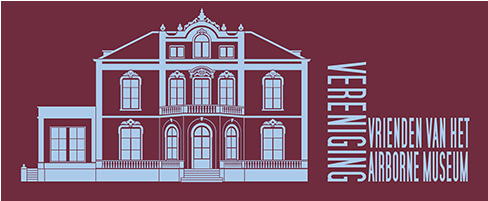
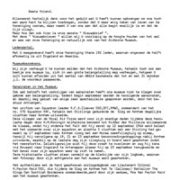
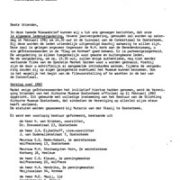
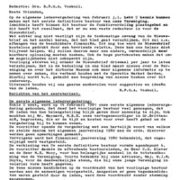
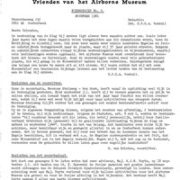
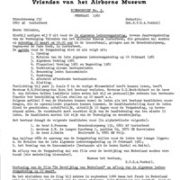
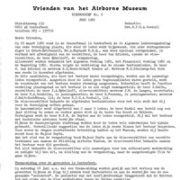
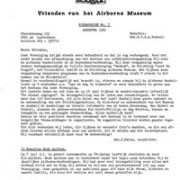
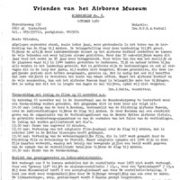
Plaats een Reactie
Vraag of reactie?Laat hier uw reactie achter.